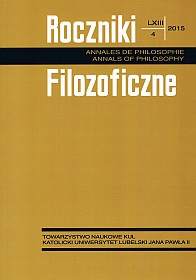Epistemological-Explanatory Dimension of the Problem of Non-Linguistic Thoughts according to José Luis Bermúdez
Abstract
Bermúdez considers the problem of non-linguistic thoughts on two dimensions: epistemological and explanatory. Epistemological dimension is how it is possible to assign thoughts to the non-linguistic creatures (hereinafter: NC) and whether it is possible to know the content of non-linguistic thought. To solve this problem Bermúdez applied success semantics to NC, which allows to know the contents of beliefs and desires and to use psychological explanation. The explanatory dimension relates to the attribution of thought to NC, which would explain their behavior. For this purpose, Bermúdez extends the concept of rationality to NC by highlighting its different levels. In addition, he extracts protologic to show how practical reasoning may be assigned to the NC. The main complaints to his position are related to following factors: the relationship between thinking and reasoning, the methodology which is used by Bermúdez and expanded concept of rationality.
References
Bermúdez, José Luis. The paradox of self-consciousness. Cambridge: MIT Press, 2000.
Bermúdez, José Luis. „Rationality and Psychological Explanation Without Language”. W: Reason and nature: essays in the theory of rationality, red. José Luis Bermúdez i Alan Millar, 233–264. Oxford: Clarendon Press, 2002.
Bermúdez, José Luis. Thinking without Words. New York: Oxford University Press, 2003.
Bermúdez, José Luis. „Nonconceptual Content: From Perceptual Experience to Subpersonal Computational States”. W: Essays on Nonconceptual Content, red. York H. Gunther, 183–216. Cambridge: MIT Press, 2003.
Bermúdez, José Luis. Philosophy of Psychology. A contemporary introduction. New York: Routledge, 2005.
Blackburn, Simon Practical Tortoise Raising: and other philosophical essays. New York: Oxford University Press, 2012.
Davidson, Donald. „Actions, reasons and causes”. Journal of Philosophy 60 (1963), 23: 685–700.
Davidson, Donald. Essays on Actions and Events. Oxford: Oxford University Press, 1980.
Dotov, Dobromir G., Lin Nie i Matthieu M. de Wit. Zrozumieć afordancje: przegląd badań nad główną tezą Jamesa J. Gibsona, przełożyli D. Lubiszewski i Nelly Strehlau. http://avant.edu.pl/wp-content/uploads/DDLNMW-Zrozumiec-afordancje.pdf [dostęp: 19.04. 2015].
Dutkowska, Anna. „Udział nauk szczegółowych w badaniach umysłów prostych”. W: Człowiek wobec wyzwań współczesnego świata, red. Maria Białonoga-Gosik, Tomasz Łach, Ewelina Bal i Konrad Zaborowski, 117–125. Lublin: Wydawnictwo KUL, 2013.
Fodor, Jerry. „More Peanuts”. London Review of Books 25 (2003), 19: 16–17.
Gierasimczuk, Nina Teoretyczny model nabywania języka według Quine’a, http://kf.mish.uw.edu.pl/kog/kog_nin.pdf [dostęp: 19.04.2015].
Łastowski, Krzysztof, i Magdalena Reuter. Ewoluujące umysły. Koncepcje, hipotezy, argumenty empiryczne. W: Przewodnik po filozofii umysłu, red. Marcin Miłkowski i Robert Poczobut, 651–688. Kraków: Wydawnictwo WAM, 2012.
Mellor, D.H. Mind, Meaning and Reality. New York: Oxford University Press, 2012.
Miłkowski, Marcin, i Robert Poczobut. „Czym jest i jak istnieje umysł”. Diametros 2005, 3: 27–55.
Schetz, Adriana. „O tak zwanym problemie prostych umysłów”. Diametros 2011, 30: 41–60.
Trojan, Maciej. Na tropie zwierzęcego umysłu. Warszawa: Wydawnictwo Naukowe SCHOLAR, 2013.
Żegleń, Urszula. „Głos w debacie na temat: ‘Czym jest i jak istnieje umysł’”. Diametros 2005, 3: 169–172.
Copyright (c) 2015 Roczniki Filozoficzne

This work is licensed under a Creative Commons Attribution-NonCommercial-NoDerivatives 4.0 International License.





